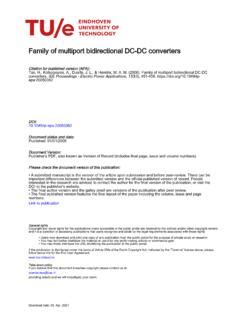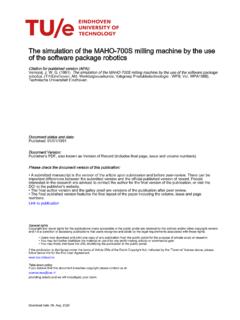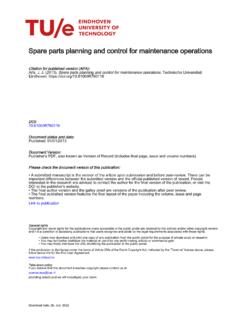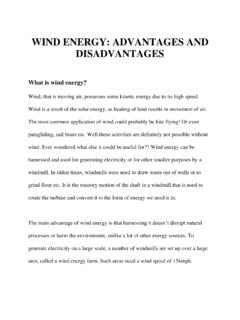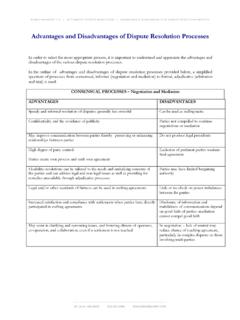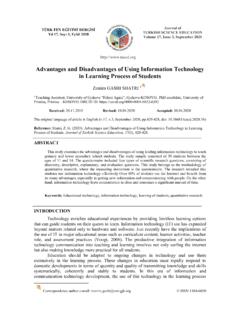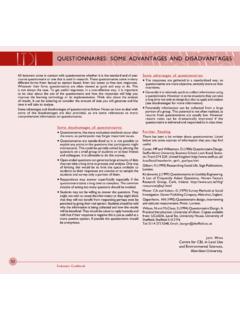Transcription of Advantages and disadvantages of four interview techniques ...
1 Advantages and disadvantages of four interview techniques inqualitative researchCitation for published version (APA):Opdenakker, R. J. G. (2006). Advantages and disadvantages of four interview techniques in qualitative Qualitative Sozialforschung = Forum : Qualitative Social Research, 7(4), status and date:Published: 01/01/2006 Document Version:Publisher s PDF, also known as Version of Record (includes final page, issue and volume numbers)Please check the document version of this publication: A submitted manuscript is the version of the article upon submission and before peer-review. There can beimportant differences between the submitted version and the official published version of record. Peopleinterested in the research are advised to contact the author for the final version of the publication, or visit theDOI to the publisher's website. The final author version and the galley proof are versions of the publication after peer review.
2 The final published version features the final layout of the paper including the volume, issue and to publicationGeneral rightsCopyright and moral rights for the publications made accessible in the public portal are retained by the authors and/or other copyright ownersand it is a condition of accessing publications that users recognise and abide by the legal requirements associated with these rights. Users may download and print one copy of any publication from the public portal for the purpose of private study or research. You may not further distribute the material or use it for any profit-making activity or commercial gain You may freely distribute the URL identifying the publication in the public the publication is distributed under the terms of Article 25fa of the Dutch Copyright Act, indicated by the Taverne license above, pleasefollow below link for the End User down policyIf you believe that this document breaches copyright please contact us details and we will investigate your date: 17.
3 May. 2022 Advantages and disadvantages of Four interview techniques in Qualitative ResearchRaymond OpdenakkerAbstract: Face-to-face interviews have long been the dominant interview technique in the field of qualitative research. In the last two decades, telephone interviewing became more and more com-mon. Due to the explosive growth of new communication forms, such as computer mediated com-munication (for example e-mail and chat boxes), other interview techniques can be introduced and used within the field of qualitative research. For a study in the domain of virtual teams, I used various communication possibilities to interview informants as well as face-to-face interviews. In this article a comparison will be made concerning the Advantages and disadvantages of face-to-face, telephone, e-mail and MSN messenger inter-views. By including telephone and MSN messenger interviews in the comparison, the scope of this article is broader than the article of BAMPTON and COWTON (2002).
4 Table of Contents1. Introduction2. Advantages and disadvantages of the Four interview Face-to-face interviews: Synchronous communication of time and Telephone interviews: Synchronous communication of time, asynchronous communication of MSN messenger interviews: Synchronous communication of time, asynchronous communication of place3. Summary4. ConclusionsAcknowledgementReferencesAuth orCitation1. IntroductionKVALE (1983, ) defines the qualitative research interview as "an interview , whose purpose is to gather descriptions of the life-world of the interviewee with respect to interpretation of the meaning of the described phenomena". Collecting these descriptions can be done in several ways, of which face-to-face interviews are the most common. Besides Face-to-Face (FtF) interviews, interviewing by telephone is popular too. But also interviewing using the Internet is rising. Due to developments in computer technology, all kinds of computer mediated com-munication (CMC) tools have been developed.
5 With CMC is meant: a process where messages are electronically transferred from a sender to one or more recipient(s), both in synchronous (in real time) and in asynchronous (independent 2006 FQS Qualitative Sozialforschung / Forum: Qualitative Social Research (ISSN 1438-5627)Volume 7, No. 4, Art. 11 September 2006 Key words: interviews, computer mediated com-munication (CMC), face-to-face interview , e-mail interview , MSN messenger interview , telephone interviewFORUM: QUALITATIVESOCIAL RESEARCHSOZIALFORSCHUNGFQS 7(4), Art. 11, Raymond Opdenakker: Advantages and disadvantages of Four interview techniques in Qualitative Researchfrom time and place) setting. Examples of tools used for CMC are e-mail and chat boxes (as MSN messenger), which also can be used for interviews. [1]The experiences with the four mentioned interview techniques were gained during my research of EU funded virtual teams, from which team members were dispersed all over Europe.
6 I tried to conduct as much FtF interviews as possible in the first place, but due to time and financial constraints this was not always possible. Also doing research on virtual teams, where FtF communication has decreased in favour of other forms of communication, paved the way for me to use other interview techniques . Although it would have been likely to establish telephone interviews, not all interviewees were in favour of it. As one interviewee remarked "We can do it (the interview ) by an Instant Messaging tool as well. If it takes an hour, I think it will be better and less disturbing for my colleagues". The focus of this research was semi-structured interviews. [2]In this article four types of interview techniques will be compared: FtF interviews, telephone interviews, MSN messenger interviews, and e-mail interviews. The focus of this article is concentrated on the ways in which the four interview techniques differ from each other, thus highlighting the Advantages and disadvantages .
7 Whenever possible, the experiences from my own interviews are mentioned. [3]2. Advantages and disadvantages of the Four interview TechniquesWhen comparing the four interview techniques , the differences in Advantages and disadvantages are on one hand related to their differences on the dimensions synchronous communication in time and/or space and asynchronous communication in time and/or space. Table 1 presents the four interview techniques related to these dimensions. TimePlaceSynchronous communicationFtFMSN messengerTelephoneFtFAsynchronous communicationE-mailE-mailMSN messengerTelephoneTable 1: The four interview techniques divided by synchronous/asynchronous communication in time and/or space [4]FtF interviews are characterised by synchronous communication in time and place. MSN messenger and telephone interviews are characterised by synchronous communication in time, but asynchronous communication in place.
8 E-mail interviews are characterised as asynchronous communication in time and 2006 FQS 7(4), Art. 11, Raymond Opdenakker: Advantages and disadvantages of Four interview techniques in Qualitative Researchplace. One could argue that MSN messenger and telephone interviews are characterised by synchronous communication in cyberspace. As cyberspace is defined as "the noplace" (MORSE, 1998), communication in a virtual place brings with it other Advantages and disadvantages than communication in a real place, as in FtF interviews. Therefore with synchronous communication of place is meant a real place, and not a virtual place. [5]On the other hand Advantages and disadvantages of the four interview techniques are related to the technology used. [6] Face-to-face interviews: Synchronous communication of time and placeAs already mentioned, FtF interviews are characterised by synchronous communication in time and place.
9 Due to this synchronous communication, as no other interview method FtF interviews can take its advantage of social cues. Social cues, such as voice, intonation, body language etc. of the interviewee can give the interviewer a lot of extra information that can be added to the verbal answer of the interviewee on a question. Of course the value of social cues also depends on what the interviewer wants to know from the interviewee. If the inter-viewer is seen as a subject, and as an irreplaceable person, from whom the interviewer wants to know the attitude towards for example the labour union, then social cues are very important. When the interviewer interviews an expert about things or persons that have nothing to do with the expert as a subject, then social cues become less important (EMANS, 1986). On the other hand this visibility can lead to disturbing interviewer effects, when the interviewer guides with his or her behaviour the interviewee in a special direction.
10 This disadvantage can be dimin-ished by using an interview protocol and by the awareness of the interviewer of this effect. [7]In FtF interviews there is no significant time delay between question and answer; the interviewer and interviewee can directly react on what the other says or does. An advantage of this synchronous communication is that the answer of the interviewee is more spontaneous, without an extended reflection. But due to this synchronous character of the medium, the interviewer must concentrate much more on the questions to be asked and the answers given. Especially when an unstructured or semi structured interview list is used, and the interviewer has to formulate questions as a result of the interactive nature of communication. WENGRAF (2001, ) even speaks of "double attention", which means "that you must be both listening to the informant's responses to understand what he or she is trying to get at and, at the same time, you must be bearing in mind your needs to ensure that all your questions are liable to get answered within the fixed time at the level of depth and detail that you need".

